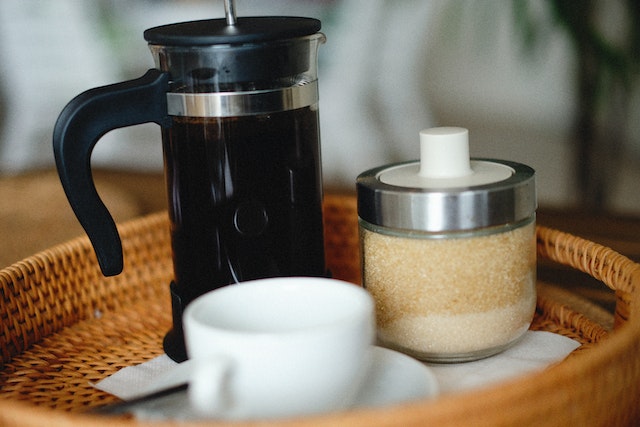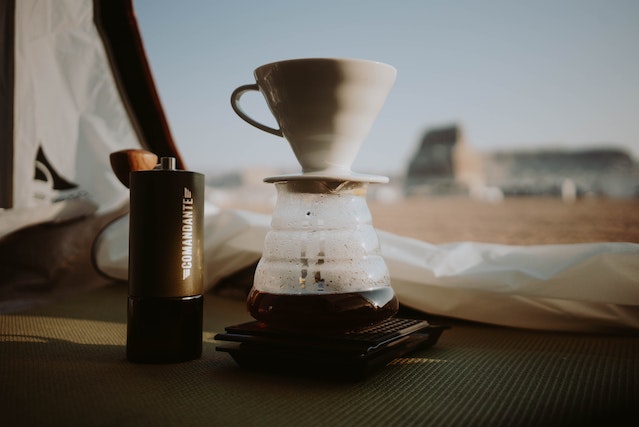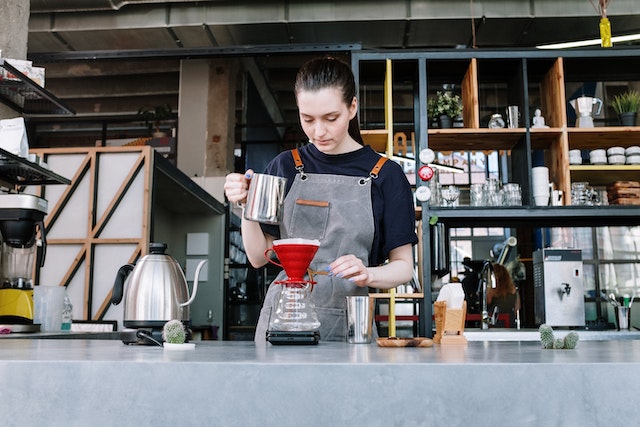Brewing coffee is an immensely personal process – everyone has their own unique preferences and techniques that they use to make the perfect cup. Even amongst those who like to brew with manual methods, there can be a lot of debate over which method reigns supreme. One of the most common debates among coffee aficionados is French Press vs Pour Over – what sets them apart and which one yields the best results? In this blog post, we’ll explore both brewing methods in depth to help you understand exactly how each one works, so you can decide for yourself which one makes coffee just how you like it!
If you’re looking to get the perfect cup of coffee every time, and a method with minimal effort then your choices come down to either French Press or Pour Over. Not only do these two methods differ in their flavor profiles but also their overall convenience – each has its own unique benefits that should be taken into consideration before deciding what brewing process is right for you. We’ll explore each side-by-side by looking at style, cost, and time so that you can make an informed decision on why French press vs pour over is best for your lifestyle.
Table of Contents
What Is French Press?
French Press, also known as a Cafetiere or a plunger pot, is an ancient method of brewing coffee that has recently become quite popular again. It involves pouring hot water into a carafe full of coarsely ground coffee beans, allowing the flavors and aromas from the beans to steep for several minutes before pushing down on the filter at the top of the carafe which forces the grounds to the bottom.
This method is ideal for those who want full control over their brew time, as it allows them to steep for as long or short of a period as they choose. The longer the steep time, the stronger and more flavorful the resulting cup will be. French Press produces bolder flavor than other methods because of its unique way of trapping all of the oils and flavors in the grounds at once. This also makes it ideal for espresso-style coffees that require high pressure extraction.

The French Press is loved by many due to its ease of use and affordability; you don’t need fancy equipment or expensive machines to make great coffee with it. All you need is ground coffee beans, hot water, and a few minutes to prepare your favorite brews. French Press offers more flexibility than other brewing methods too – you can experiment with different grind sizes and steep times to find what works best for your taste preference.
Aside from being budget-friendly and easy to use, French Press coffee has several health benefits too! Studies have shown that compared with other methods such as drip or percolation, French Press coffee contains higher levels of antioxidants which can help reduce inflammation in your body. Moreover, since no paper filters are used when brewing with this method, there is less waste involved since you don’t have any disposable materials after each use.
Overall, French Press provides an unparalleled level of quality, convenience and affordability which makes it one of the most beloved ways to enjoy delicious cups of coffee every day!
How To Use A French Press?
Using a French Press is an excellent way to make a delicious cup of coffee. To ensure you get the best results, here are some tips for how to use a French press.
First, start by measuring out the correct amount of coffee grounds and water for your desired cup size. If you’re unsure how much to add, as a general rule, use two tablespoons of ground coffee per six ounces of water. For best flavor profiles, we recommend using freshly ground beans.
Next, heat up the water until it’s just below boiling (around 205°F). It’s important not to overheat your water in order to avoid burning the grounds and creating a bitter taste. Once your water has reached the proper temperature, fill the carafe with hot water and pour it over the grounds. Then give everything a gentle stir and cover it with the plunger lid.
Once all of your ingredients are in place let them steep for about three minutes. This will allow all of the flavors from the coffee grounds to fully blend into the drink. After three minutes has elapsed slowly press down on the plunger until you feel some resistance—typically about two minutes—then pull back up slightly as this will help make sure that all of the sediment doesn’t pass through into your final drink. Lastly, pour out your french press coffee and enjoy!
When brewing multiple cups with one French press it’s important to note that after each brew cycle you should clean out any remaining sediment before making more coffee so that each new cup is consistently flavorful. Additionally, if you’re using pre-ground beans we recommend grinding them right before brewing each cup in order to preserve maximum quality and taste profile since pre-ground beans can lose their flavor quickly when exposed to air or light. Finally, if you’re not planning on drinking all of your French press immediately consider pouring it over ice or saving some for later; cold brewed French press can last up to 24 hours if stored properly in an airtight container or jar in the refrigerator!
What Are The Benefits Of Using A French Press?

One of the main benefits of using a French Press is its ability to produce an incredibly rich and flavorful cup of coffee. Unlike traditional drip machines or single-serve brewers, the French Press does not use paper filters, meaning all of the natural oils from the coffee beans are present in the final product. This provides a fuller body, more intense flavor profile, and even more caffeine than other brewing methods. Additionally, French Presses are incredibly easy to use, with full control over brew time and temperature allowing you to customize each pot to your exact specifications.
The French Press also retains essential volatile compounds which provide it with its unique flavor. These compounds can be destroyed by other brewing methods that use paper filters as they are quite delicate and sensitive to heat. The pressing action of the French press ensures these compounds remain present in the final product so you can enjoy their delicious nuances.
The metal mesh filter used in most French Presses also serves a dual purpose – it traps natural solids like grounds while still allowing fine particles (such as oils) to pass through into your cup. This allows all of the delicious flavors from freshly ground beans to be included in each sip without any additional bitterness from passing through a paper filter where some may get left behind.
Another advantage of using a French Press is its portability; you simply boil water in any kettle then pour into the press and wait for your coffee to steep before pressing the plunger down on top. Since no electrical connection is necessary, this makes them ideal for camping trips or taking along on vacation when electricity might not be available. All you need is hot water, ground beans and somewhere to store your finished drink – making this an ideal option for those who love great tasting coffee but don’t necessarily have access to traditional espresso equipment!
What Is Pour Over Coffee?
Pour over coffee is a brewing method for making coffee that has become increasingly popular in recent years. The process involves slowly pouring hot water over ground coffee beans, allowing the flavor to steep into the water, and then draining the resulting beverage through a filter into a carafe or mug. This type of brewing method can be used with any type of coffee bean, but is especially popular with specialty coffees such as light roast coffees or single-origin beans.

The pour over technique requires patience and precision, but produces a cup of coffee that connoisseurs are sure to appreciate. Using this method allows the user to control all aspects of the brewing process, from grind size to water temperature and even the speed at which they pour. This enables the user to customize their cup of joe to their exact preferences. The key advantage is that it ensures each cup lives up to its full potential in terms of both flavor and aroma.
In addition, using the pour over method means minimal waste since no paper filters are required and there is only enough grounds for one cup at a time (versus pre-ground store bought varieties). In fact, many believe this creates less waste since it’s best practice to discard pre-ground beans after about two weeks due to oxidation reducing flavor and aroma quality.
Pour over coffee may take some practice before you get it just right, but it’s well worth your effort when you sip on those perfect cups!
How Do I Make Pour Over Coffee?
Making pour over coffee is a great way to enjoy the freshest cup of joe. It’s simple, only requiring a few tools and easy-to-follow steps.
First, you’ll need a pour over brewer, such as the Chemex or Hario V60. You’ll also need coarsely ground coffee and hot water. The grind size should be like sea salt so that it passes through the filter easily but still provides enough flavor extraction.
Start by heating up your water to 200°F (93°C). When ready, place your filter in the brewer and rinse it with hot water to remove any paper taste. This pre-wetting will also heat up your brewer slightly while you prepare the coffee grounds.
Once your filter is rinsed, discard the water and add your freshly ground coffee into the filter—around 20–30 grams for a large mug or 40–50 grams for two cups. Give it a slight shake to level out the grounds before inserting it into the brewer over your mug or carafe.
Slowly start pouring your hot water over the grounds in concentric circles from center outward and make sure all of them are wet equally before letting the liquid fill up half of the brewer’s chamber height above the grounds. Give it a stir if needed to fully saturate all of them.
Continue slowly pouring more hot water in circles until you reach about an inch away from top edge of brewer’s chamber—the remaining empty space allows for bloom expansion when additional water is added later on during brewing process. Let this first round steep for around 45 seconds before adding more hot water until desired strength is reached (usually around 3–4 minutes). Once finished, discard used grounds and enjoy!
>>> You may like this:
Best Indoor Smokeless Grill Consumer Reports
How to clean Nespresso machine?
What Are The Benefits Of Pour Over Coffee?

Pour over coffee is a time-honored method of brewing that yields a delicious cup of coffee. It has become increasingly popular in recent years due to its distinct flavor profile, its ability to bring out the best flavors from a variety of different beans, and its convenience compared to other methods of brewing. There are several key benefits that make pour over coffee an ideal choice for coffee connoisseurs and casual drinkers alike.
One major benefit of pour over coffee is the level of control it gives the drinker. Because it involves manually dripping hot water through freshly ground beans, you have total control over the amount of time it takes to brew and how strong or weak you’d like the end product to be. This makes pour over an ideal choice for those who want to customize their cup according to their own preferences or experiment with different types of beans and grinds.
Another great benefit is that pour over coffee allows for a more efficient use of grounds compared to other methods like French press or drip machines. With pour over, you can use very specific amounts of grounds (measured by weight) for each cup instead of relying on pre-set measurements which may not always be accurate. This helps ensure that your finished product will have an optimal flavor profile without wasting any grounds.
A final perk is that with pour over coffee comes less equipment than other methods require, making it easier to take on the go if desired. You don’t need any bulky electric equipment; all you need is your beans, some filters, and a simple dripper made from plastic or ceramic materials (or even just a mug). That makes it easier than ever before to enjoy your favorite type of coffee while traveling or spending time outdoors without having to lug around heavy equipment.
All in all, pour over coffee offers multiple advantages that make this timeless method an attractive option for both experienced baristas and novice drinkers alike. Its portability and its level of precision give it an edge when compared with other popular brewing methods – not least because it can bring out the best flavors from whatever type of bean you choose!
French Press Vs Pour Over Coffee Comparison
French Press Vs Pour Over Coffee Comparison
When it comes to coffee brewing, there are several different methods to choose from. Of these, two of the most popular are French press and pour over. Both of these methods have their own distinct advantages and disadvantages, making them suitable for different situations.
With a French press, you will typically use a coarser grind than with a pour over. This is because the mesh filter at the bottom of the plunger helps to keep larger particles out of the coffee while allowing some sediment through. The result is usually bolder flavor and an intense aroma that many people find appealing. On the downside, French press may take longer to brew as it requires more time to steep in order to extract all of the flavors and aromatic oils from the beans. It also tends to retain more heat than other methods, making it best suited for those who prefer their coffee hot or even piping hot.
In comparison, pour over involves pouring hot water directly over ground coffee beans that have been placed on top of a filter in a cup or mug. This method allows more flavor to come through without any bitterness that can be attributed to excessive steeping. It also has the advantage of being much faster than using a French press so you can get your cup of joe within minutes instead of waiting for several minutes for one cup when using a French press method. However, since you’re not using any sort of plunger in this method, some finer grounds may pass through into your cup which can create an unpleasant experience if you’re not careful about filtering correctly.
Overall though, both brewing methods have their pros and cons and choosing one ultimately depends on personal preference as well as one’s individual needs when brewing coffee at home or while traveling. If you want strong flavor with slightly coarse texture then go with French press; however if you want something faster with clearer tasting notes then pour over will be your better option. Either way, both methods offer excellent experiences when done properly!
>>> See more: The Ultimate French Press Technique
Conclusion
There are many ways to make a great cup of coffee, but it really comes down to two methods: French press vs pour over. Both have their own set of pros and cons, so it’s really up to the coffee drinker to decide which method they prefer. If you like a bolder cup of coffee, the French Press is likely the brewing method for you. If you prefer a cleaner taste, go with Pour Over. When it comes to price and simplicity, the French Press wins again. At the end of the day, it’s up to you to decide which brewing method suits your fancy. Do some research, experiment with both methods, and find what works best for you.
Welcome to the Cafe Toscana Restaurant blog! Here you’ll find all the latest news, events, and happenings at our restaurant. We’ll also share our favorite recipes, tips, and tricks for enjoying a delicious. Stay tuned for all the latest from Cafe Toscana!

